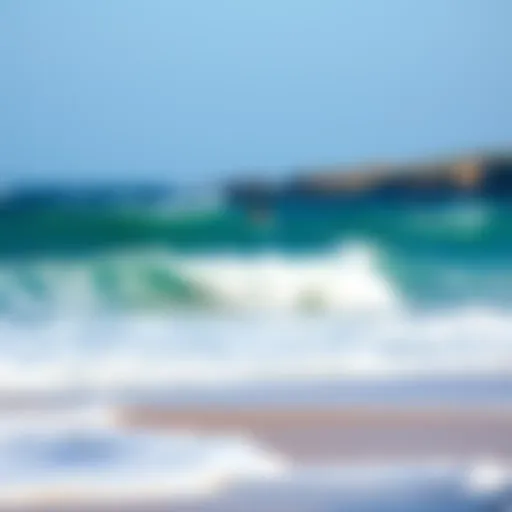Kiteboarding Lessons in San Francisco: A Complete Guide


Intro
Kiteboarding is not just a sport; it’s a fusion of adrenaline, skill, and the beauty of nature, especially when set against the stunning backdrop of San Francisco. From the iconic Golden Gate Bridge to the sprawling shores of Ocean Beach, this city offers a unique playground for both beginners and seasoned kiteboarders alike. The blend of strong winds and diverse water conditions creates an ideal environment for anyone looking to ride the waves with a kite.
Engaging in kiteboarding lessons can be a transformative experience. It’s not just about learning how to control the kite or mastering the board; it's about embracing the wind and water dance that makes the sport so thrilling. This guide delves deep into what aspiring kiteboarders can expect from lessons in San Francisco.
Expert Insights
Kiteboarding has been gaining traction over recent years, not just as a leisurely pursuit but as a competitive sport. Enthusiasts are always eager to stay updated on the latest trends that shape the kiteboarding landscape.
Latest Trends in Watersports
The watersport landscape is continuously evolving. In recent years, the rise of hydrofoiling has taken kiteboarding to new heights—literally. This technique involves riding a board that lifts above the water’s surface, delivering a sensation akin to flying. Many kiteboarding schools in San Francisco have incorporated hydrofoiling lessons into their curriculums, catering to advanced riders looking for that next thrill.
Additionally, the environmental impact of equipment has come under scrutiny, leading to more eco-friendly options. Brands are developing recyclable materials for kite fabrics and harnesses, appealing to conscience-driven athletes. For those seeking to combine their passion for the sport with a commitment to sustainability, this trend is well worth considering.
Safety Protocols and Best Practices
Safety in kiteboarding can't be stressed enough. Sandy beaches may beckon, but the ocean's temperament is not always friendly. Before hitting the water, familiarizing yourself with local regulations is crucial. San Francisco’s kiteboarding hotspots often have specific guidelines regarding where and when you can set sail. Here are some basic safety protocols to keep in mind:
- Check the Wind Conditions: Always assess wind speeds and direction before starting. Certain beaches in San Francisco have ideal wind conditions, while others may not.
- Wear the Right Gear: A proper harness, helmet, and impact vest can protect against falls and unexpected waves. Having a buoyancy aid can also be a smart move.
- Know Your Surroundings: Local surfers and swimmers may not be your only concern. Stay aware of your environment, including other kiteboarders, and always give them ample space.
- Practice Self-Rescue Techniques: Before venturing out, make sure you’re well-versed in self-rescue techniques. Falling off or being dragged by a kite can lead to dangerous situations, and knowing what to do places responsibility on your shoulders.
"In the world of kiteboarding, preparedness outweighs bravado. Always approach the water with respect and knowledge."
Equipment Recommendations
Choosing the right equipment can make or break your kiteboarding experience. With a spectrum ranging from beginner-friendly to professional-grade gear, navigating this landscape may feel daunting.
Must-Have Gear for Beginners
For novices just starting, investing in quality equipment can expedite the learning process:
- Kite: Look for a beginner-friendly, lightweight kite that offers stability. Brands like Naish and Cabrinha often have entry-level options.
- Board: A larger board provides better buoyancy, making it easier to balance on the water. A twin-tip design tends to be the favorite among newcomers.
- Harness: Comfort is key; a well-fitted harness allows for better control. Look for options that have padding to prevent chafing during extended sessions.
Advanced Equipment for Pros
Once you find your footing and feel more confident, stepping up your equipment can elevate your kiteboarding game:
- High-Aspect Ratio Kites: For experienced riders, kites with this design provide better speed and lift, perfect for performing jumps.
- Performance Boards: Strapped boards designed for handling high speeds can be a game-changer for advanced tricks.
- Accessories: Anti-ventilated lycra tops or lightweight wetsuits can enhance your experience, allowing you to concentrate on the thrill rather than discomfort.
San Francisco stands as a prime location for kiteboarding, not solely for its breathtaking vistas but also for its engaging community and practice opportunities. With proper lessons, good equipment, and a safety-first mindset, your kiteboarding journey can be as enriching as the waves you're riding.
Foreword to Kiteboarding in San Francisco
Kiteboarding is not just a sport; it's a blend of passion, thrill, and a deep connection with the elements. In San Francisco, kiteboarding takes on a unique character, shaped by the city's stunning coastal vistas and dynamic wind conditions. This vibrant city, perched on the edge of the Pacific Ocean, offers exceptional opportunities for both newcomers and seasoned riders to glide across the water with grace.
Understanding the landscape of kiteboarding in San Francisco is crucial for anyone aiming to navigate this exhilarating activity. From the iconic Golden Gate Bridge framing your view while you ride to the rugged beaches that line the coastline, the scenery adds a special dimension to every session on the water.
Importance and Benefits
Engaging in kiteboarding here opens doors to numerous benefits:
- Natural Beauty: The rich tapestry of the coastline provides a breathtaking backdrop, enhancing the overall experience of the sport. Each sunset can turn the water into a shimmering canvas, making every ride memorable.
- Ideal Wind Conditions: San Francisco is known for its consistent wind, particularly during the summer months. These conditions are what draw many to learn and master their skills—whether it's the steady bay breeze or wind whipping in from the ocean.
- Diverse Community: The city’s kiteboarding community is inclusive and passionate. Joining local groups or clubs not only aids learning but fosters friendships—all bonded by a shared love for the sport.
Considerations in Learning
While kiteboarding is thrilling, it's not without its challenges. Newcomers should prepare for:
- Weather Variability: Understanding how weather influences wind patterns is key. This knowledge helps in choosing the right time and location to hit the water.
- Safety Awareness: With wind, water, and equipment involved, being mindful of safety protocols is critical. Novice kiteboarders are encouraged to seek professional lessons to build a solid foundation before venturing out solo.
Understanding Kiteboarding
Kiteboarding is more than just a sport; it's an exhilarating combination of wind, water, and skill. Understanding its intricate components allows enthusiasts and newcomers alike to appreciate the depth and nuances this activity offers. For those living or visiting San Francisco, grasping the essence of kiteboarding is essential for making the most of their experience. This section will cover its history and the physics that underpin this captivating sport, ensuring you know not just how to kiteboard, but why it is such a unique thrill.
History of Kiteboarding
The roots of kiteboarding stretch back several centuries, but its modern incarnation began in the late 20th century. Originally, kites were used for various purposes, including military signaling and meteorological observations. The transition to recreational use began when pioneers started to experiment with surfboards and kites together.
In the 1970s and 80s, inventors like Gijsbertus Adrianus Panhuise and others began crafting equipment that would evolve to become the kiteboards we know today. Yet, it was not until the 1990s that kiteboarding truly took flight as a recognized sport. Visionaries like Maarten Baas and others refined the design of kites, enhancing stability and control.
In 1998, the sport’s presence solidified with the establishment of kiteboarding competitions and organizations that tethered passionate kiteboarders together globally. The sport quickly gained popularity due to its combination of thrill and freedom.
"Kiteboarding isn’t just about riding the waves; it’s a dance with nature you’ll never forget."
Considering the historical context gives novice kiteboarders a deeper appreciation of its journey. The skateboarding and surfing roots manifest through the various styles available in kiteboarding today—from freestyle to wave riding and everything in-between.
The Physics of Kiteboarding
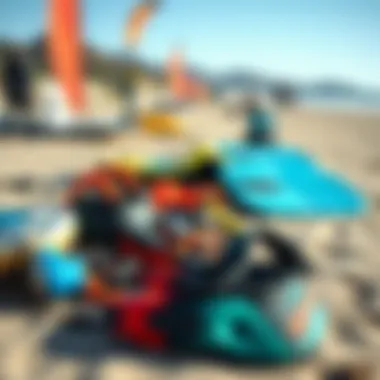
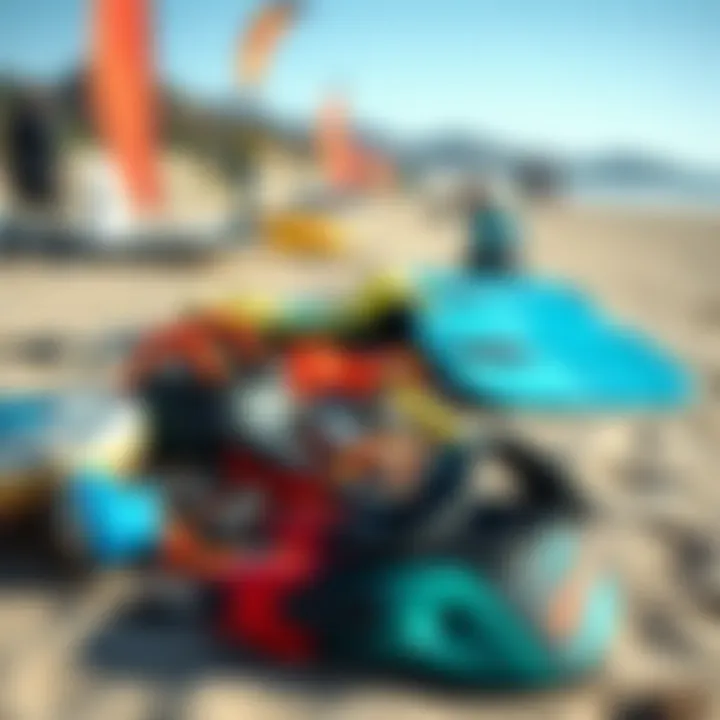
Kiteboarding operates on fundamental principles grounded in physics—principally, the interaction between lift, drag, and the tension in the lines. When the kite catches the wind, it generates lift, allowing the rider to ascend above the water's surface. This principle is similar to how an airplane wing works, where the shape of the wing allows air to move faster over the top, creating lower pressure compared to the bottom.
Another crucial aspect is understanding drag. As the kite moves through the air, it encounters resistance, which the rider must manage for optimal control and speed. The design of the kite itself plays a pivotal role in how it handles wind and water dynamics.
Furthermore, the center of gravity and balance are vital for mastery. Kiteboarding isn't just about being pulled by the kite; it’s about finding harmony between body mechanics and kite control.
Consider these points:
- The angle of attack of the kite significantly impacts how much lift it generates.
- Effective body positioning can directly influence speed and agility.
- Timing and coordination are essential to ride smoothly over varying water surfaces.
By understanding these elements, kiteboarders can refine their techniques, improving safety and performance on the water. Ultimately, knowledge of the physics involved in kiteboarding can turn a novice into a skillful participant, ready to tackle the waves and winds of San Francisco.
Geographic Advantage of San Francisco
San Francisco stands out as a premier destination for kiteboarding, not just by chance but due to its unique geographical and climatic advantages. The city's unpredictable weather patterns and diverse aquatic landscapes make it an ideal playground for kiteboarders, whether they are just starting out or are seasoned pros looking for a new challenge. In this section, we will delve into two crucial aspects that contribute to San Francisco's kiteboarding appeal: wind conditions and the variety of waterways and beaches.
Wind Conditions
The wind in San Francisco is nothing short of legendary among kiteboarders. Its consistency and strength create favorable conditions that can elevate the learning experience and push seasoned athletes to their limits. Most notably, the famed "San Francisco breeze" often picks up in the afternoon, thanks to the coastal topography and the thermal difference between the ocean and the land. As the warm air rises, cooler ocean air rushes in, generating winds that can easily reach speeds of 15 to 25 mph or more.
This reliable wind pattern is essential for kiteboarding, where a steady breeze is a kiteboarder's best friend. It allows learners to develop their skills without the frustration of uncontrollable gusts, while advanced kiteboarders can take advantage of strong winds to perform complex tricks.
"The steady winds in San Francisco are like clockwork, turning an afternoon into an exhilarating adventure on the water."
Waterways and Beaches
Another essential element of San Francisco’s geographic advantage is its extensive network of waterways and beaches, each providing distinct conditions suitable for different skill levels. From the iconic Ocean Beach, which offers the thrill of larger waves and open spaces, to the calmer waters of Crissy Field, there’s a spot for everyone.
- Ocean Beach: Known for its powerful surf and lively atmosphere, this beach is better suited for experienced riders who enjoy tackling challenging waves.
- Crissy Field: This area is particularly favored by beginners due to its flat waters and gentle winds, allowing new kiteboarders to master the basics. The stunning backdrop of the Golden Gate Bridge adds to the allure, making every session feel like a mini-vacation.
- The Bay: The San Francisco Bay offers a unique setting for kiteboarding with its sheltered areas and varied wind patterns. Here, riders can encounter different conditions, challenging themselves while taking in the views of the bustling city.
Understanding these geographical advantages is key when embarking on your kiteboarding journey in San Francisco. Not only do the wind and water conditions enhance your experience, but they also present a valuable opportunity for growth—transforming every session into a worthwhile adventure.
Types of Kiteboarding Lessons Available
When starting out in kiteboarding, understanding the various lesson formats available can make a world of difference. It's not merely about picking a course; it's about finding the right fit that aligns with individual learning style and goals. This section sheds light on the three primary types of lessons offered: Private Lessons, Group Lessons, and Intensive Courses. By recognizing their distinctive features, benefits, and suitability, you can chart a clear course for your kiteboarding journey.
Private Lessons
Private lessons provide a tailored approach to learning kiteboarding. Instructors focus solely on one student, allowing for personalized guidance and immediate feedback. This format suits individuals who prefer to work at their own pace or have specific skills they want to develop. In these lessons, you can expect:
- Customized Instruction: The lessons adapt to your skill level and speed of learning. If you struggle with a particular technique, your instructor can pivot and spend more time addressing that.
- Flexible Schedule: Often, private lessons can be arranged at timings that suit you, which isn't always the case with group sessions.
- One-on-One Attention: With the instructor focused entirely on you, there's less chance of distractions that can often occur in a group setting.
For those who thrive on personal interaction or have specific outcomes in mind, private lessons can be a game-changer.
Group Lessons
Group lessons, in contrast, often foster a sense of community and shared learning among participants. Usually consisting of three to six students, these lessons enable individuals to learn alongside others at a similar skill level. The advantages of group lessons include:
- Cost-Effective: Group lessons are typically cheaper than private sessions, making them appealing for those on a budget.
- Social Interaction: Learning with peers can enhance motivation and make the experience more enjoyable; camaraderie might even help to alleviate nerves.
- Learning from Others: Observing fellow students can provide insights and help reinforce your own learning. Watching someone else tackle a challenging maneuver often helps you understand it better.
Despite the benefits, it's worth noting that group lessons may not allow for as much personalized attention as private lessons, but they do cultivate a fun atmosphere that's hard to beat.
Intensive Courses
Those serious about immersing themselves in kiteboarding might opt for an intensive course. Typically spanning several days, these programs are designed for students willing to dedicate significant time to honing their skills. Characteristics of intensive courses often include:
- Comprehensive Learning: These courses cover a wide range of topics in-depth, from setup to advanced techniques. You will likely progress faster compared to standard lessons due to the concentrated approach.
- Structured Curriculum: Unlike one-off lessons, intensive courses follow a structured curriculum, ensuring that key concepts are mastered sequentially.
- Extended Practice Time: With several hours dedicated daily, participants can practice effectively, leading to better retention of skills.
For people with a strong commitment to improving their kiteboarding abilities, intensive courses can serve as an invaluable resource, propelling them toward their goals in a shorter timeframe.
Selecting the Right Instructor
Choosing the right instructor is vital when it comes to kiteboarding. While the sport itself is thrilling, having the right guide can mean the difference between a joyous learning experience and a frustrating one. An instructor doesn’t just teach you how to maneuver the kite and board; they also instill confidence and ensure safety in the water. This is particularly important for beginners who might find themselves overwhelmed by new experiences.
When selecting an instructor, it is essential to look beyond just the price and the convenience of location. The rapport you build with your instructor can greatly enhance your learning process. A good instructor will tailor their teaching methods to suit your individual needs, ensuring that lessons are not only educational but also engaging.
Qualifications to Consider
There are several qualifications you should keep in mind while on the hunt for an instructor:
- Certification: Confirm that the instructor holds a valid certification from a recognized kiteboarding association. Certifications like those from the International Kiteboarding Organization (IKO) ensure that instructors have undergone rigorous training and adhere to safety standards.
- Experience: Look for someone with substantial experience, especially in teaching beginners. Instructors who have spent several seasons on the water often have a wealth of practical knowledge to share.
- Local Knowledge: An instructor familiar with San Francisco's specific wind patterns and water conditions can provide insights that are crucial for a safe and enjoyable experience.
- First Aid Training: Safety should be a top priority. Instructors with first aid and CPR certifications may handle emergencies if they arise during lessons.
Teaching Styles
Different instructors may take various approaches to teaching, and understanding these styles can help in your selection:
- Hands-On Approach: Some instructors prefer to jump right in, allowing students to feel the kite and board under their control from the get-go. This method fosters a sense of independence early on, but it can be daunting for some beginners.
- Step-by-Step Method: Others may opt for a more methodical approach, breaking down skills into smaller, manageable pieces. This can provide a solid foundation, particularly for those who appreciate a structured learning environment.
- Interactive Learning: Certain instructors might incorporate games or challenges into their lessons, making it easier to grasp concepts while having fun. This style can be particularly effective for younger learners or those seeking a lighter atmosphere.
Ultimately, finding an instructor whose style resonates with your learning preferences can significantly enhance your progress and enjoyment in this vibrant sport.
What's crucial is to have open communication with potential instructors. Don't hesitate to ask them about their teaching philosophies, past student experiences, and their strategies for cultivating a supportive learning environment. The right fit can lead to impressive advancements in your kiteboarding journey.
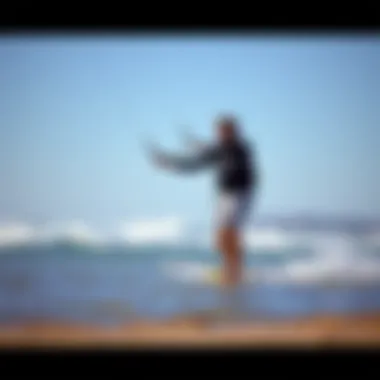
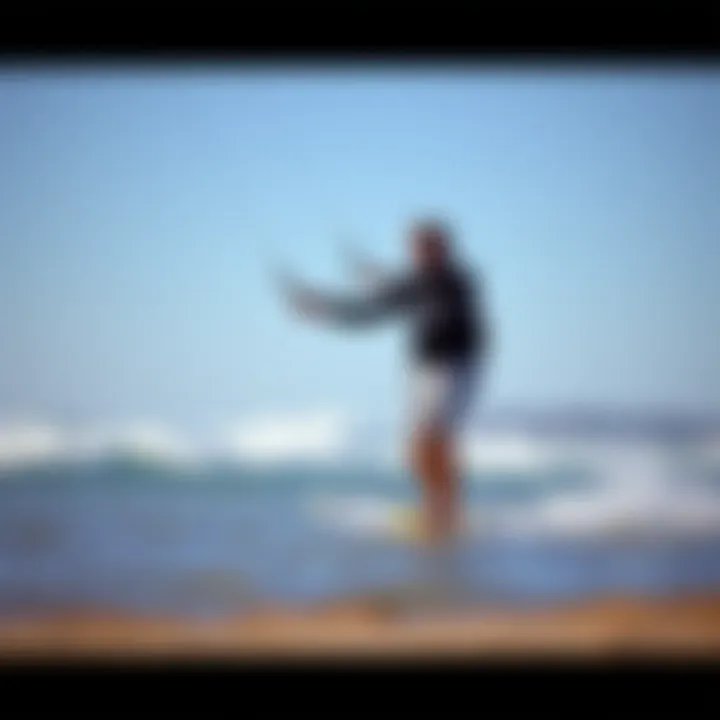
Essential Equipment for Kiteboarding
When it comes to kiteboarding, your gear is like a lifeline. Having the right equipment isn’t just about enhancing your enjoyment; it’s also essential for your safety and performance on the water. Whether you're a novice or seasoned rider, understanding your gear inside and out is vital for optimizing your experience.
Kites
The kite is, without question, the centerpiece of your kiteboarding setup. These flying canvas canopies come in different shapes and sizes, each tailored for various conditions. Most kites are categorized into two main types:
- LEI (Leading Edge Inflatable): Commonly used for most types of riding, these kites contain inflatable struts that keep the leading edge rigid, allowing for greater stability and lift.
- Foil Kites: Primarily used for light wind conditions and often preferred by those venturing into racing or speed disciplines. These kites don't require inflation, utilizing air flowing into their cells to create lift.
When selecting a kite, reckon with several factors, such as your weight, skill level, and the wind conditions typical for San Francisco beaches. A kite that's too big can be challenging to control, while one that's too small won't catch enough wind. Finding that sweet spot can make the difference between a day of fun or a frustrating struggle.
Boards
The board you choose impacts how you ride and what kind of experience you have. Much like kites, boards come in various forms, broadly split between freestyle, freeride, and wave-focused designs.
- Freestyle Boards: These are usually shorter and designed to help execute tricks on flat water or waves. They have a softer flex which is beneficial for jumping.
- Freeride Boards: A good choice for beginners, these boards provide stability and are versatile across various conditions.
- Wave Boards: If you’re looking to ride the swells, a wave board is often more dynamic and features a design that helps cut through choppy water.
Your board should match not just your riding style but also your skill level. A more advanced rider might want something with less flex for better response, while a beginner might find that a more forgiving board reduces the likelihood of wipeouts.
Safety Gear
Safety gear might not be the first thing on a rider’s mind, yet it is something that should never be overlooked. No matter how skilled you feel, having the right protective equipment offers peace of mind and might be crucial in an emergency situation. Key items you should consider include:
- Life Jackets: A Personal Flotation Device (PFD) is vital. It assures you will stay afloat in unexpected situations.
- Helmets: Protect your head from accidental falls or collisions with your board or other riders. Nowadays, there are some light-weight models available that won’t take away from your comfort.
- Impact Vests: These provide additional protection against falls and rough water. Designed to absorb impact, they can help reduce injury.
Remember, safety gear is an investment in your future kiteboarding experiences. The right equipment keeps you in the game longer, helping to avoid catastrophic injuries.
For more insights into kites and boards, you can check Wikipedia on Kiteboarding or visit local Kiteboarding Clubs to connect with fellow enthusiasts.
Safety Protocols in Kiteboarding
The excitement that kiteboarding brings is undeniable, but with that thrill comes a level of risk that cannot be overlooked. Safety protocols in kiteboarding serve as the backbone of this exhilarating sport, ensuring that both novices and seasoned riders can enjoy the winds and waves without undue peril. Understanding these protocols is crucial not only for personal safety but for fostering a responsible kiteboarding community.
Understanding Risks
Kiteboarding involves various risks that can catch even the most vigilant rider off guard. One of the primary risks is the power of the wind, which can change direction or intensity unexpectedly. A strong gust can drag an inexperienced rider off course, potentially leading to collisions or falls in rough waters. Additionally, there’s the possibility of equipment failure. For instance, if a kite’s lines snap, it can lead to loss of control, causing accidents for both the rider and nearby individuals.
Apart from equipment and environmental factors, one must also consider the physical risks involved. Kiteboarding requires balance, strength, and coordination. A sudden slip or miscalculation might lead to falls, causing injuries ranging from sprains to more severe impact injuries.
Awareness of these hazards can equip riders to be better prepared and can significantly reduce the chances of accidents. Pre-lesson safety briefings, where instructors go over anticipated risks, can greatly enhance one's understanding and readiness. As the adage goes, "An ounce of prevention is worth a pound of cure."
Emergency Procedures
In the world of kiteboarding, knowing how to react in emergencies can very well mean the difference between a minor inconvenience and a serious situation. Having clear procedures can mitigate risks effectively. Here are some key aspects often covered in emergency drills:
- Know Your Gear: Familiarizing oneself with how to quickly depower the kite in case of emergencies is essential. Riders should practice the release mechanism of their kites until it becomes second nature.
- Buddy System: Employing a buddy system can significantly enhance safety. When heading out to the water, riders should ensure that they are not alone. A partner can assist in monitoring conditions, provide support in case of a fall, or alert authorities if needed.
- Signal for Help: Knowing how to signal for help can be vital. Whether it’s through hand signals or utilizing a whistle, effective communication could expedite assistance in dire situations.
- Evacuation Routes: In any area prone to high winds or rapidly changing weather, having predetermined safe spots for retreat is crucial. Riders should familiarize themselves with the nearest beaches or designated safe areas.
Training sessions often cover these protocols, ensuring that safety becomes a habitual part of the kiteboarding experience. Understanding how to implement these emergency procedures can build confidence and foster a culture of safety among kiteboarding enthusiasts.
For kiteboarders, preparation is not just an option; it’s a necessity. Being well-versed in safety protocols can transform a thrilling adventure into a safe and enjoyable experience.
In summary, the essence of safety in kiteboarding combines training, awareness, and preparedness. By focusing on both understanding risks and implementing robust emergency procedures, the kiteboarding community can thrive, allowing for fantastic experiences while keeping safety at the forefront.
Permits and Regulations
Understanding the permits and regulations associated with kiteboarding in San Francisco is crucial for both recreational enthusiasts and seasoned athletes. Navigating these rules not only ensures a smooth experience on the water but also preserves the natural beauty of the area while fostering a respectful relationship with the environment and the local community.
Local Laws
Local laws governing kiteboarding in San Francisco are established to ensure safety on both the water and land, protecting users and the surrounding wildlife. Here’s what you need to know:
- Designated Areas: Kiteboarding is typically restricted to specific areas in San Francisco. Locations such as Crissy Field, Baker Beach, and Ocean Beach have specific zones where activities are permitted. Knowing where to go can save you potential fines and conflicts with other beachgoers.
- Time Restrictions: Some areas may impose time restrictions; for instance, kiteboarding might be allowed only during certain days or hours to prevent overcrowding or accidents. Always check the latest updates from local authorities, such as the Golden Gate National Park, which oversees Crissy Field and other beaches.
- Registration of Equipment: While most kiteboarders do not need a special permit to operate their gear, registering equipment with local clubs or organizations can offer protection and accountability within the kiteboarding community.
As legislation evolves, keeping up with local laws is your best bet. Regularly check websites of local governing bodies, like the City and County of San Francisco (www.sfgov.org), for the most current information.
Environmental Considerations
Environmental considerations are paramount when it comes to kiteboarding. Engaging in this sport not only brings joy and adventure but also carries a responsibility to protect our natural habitats. Here are key points to reflect on:
- Wildlife Preservation: San Francisco is home to a variety of ecosystems. Birds flock to certain beaches, and seals sunbathe along the coast. Understanding local wildlife patterns can help you engage in responsible kiteboarding. Avoid launching or landing kites near nesting areas or during sensitive seasons.
- Leave No Trace: Following leave no trace principles is essential. Carry out everything you bring in and avoid creating disturbances on the beach. This ensures that kiteboarding remains a viable sport for future enthusiasts.
- Pollution Awareness: Kiteboarding typically results in minimal waste, but being vigilant about any littering is necessary. Residues from sunscreen and snacks can harm marine life, so opt for reef-safe products and biodegradable packing.
Remember, every action counts! Protecting the precious environment ensures that we can enjoy kiteboarding for years to come.
In short, understanding local laws and environmental considerations is vital for any kiteboarder looking to make the most of their experience in San Francisco. Complying with guidelines helps maintain safety and preserves the stunning landscapes and wildlife that cater to our favorite pastime. By forging a responsible path forward, each kiteboarder plays a part in enjoying and protecting these vibrant waters.
Achieving Progress in Kiteboarding
Kiteboarding, as thrilling as it may seem, requires a roadmap for skill development. Just like blowing a sailboat smoothly down a river, progress in kiteboarding can take time and effort. Setting clear, measurable goals and recognizing common hurdles can pave the way for advancement, making each ride more enjoyable and fulfilling.

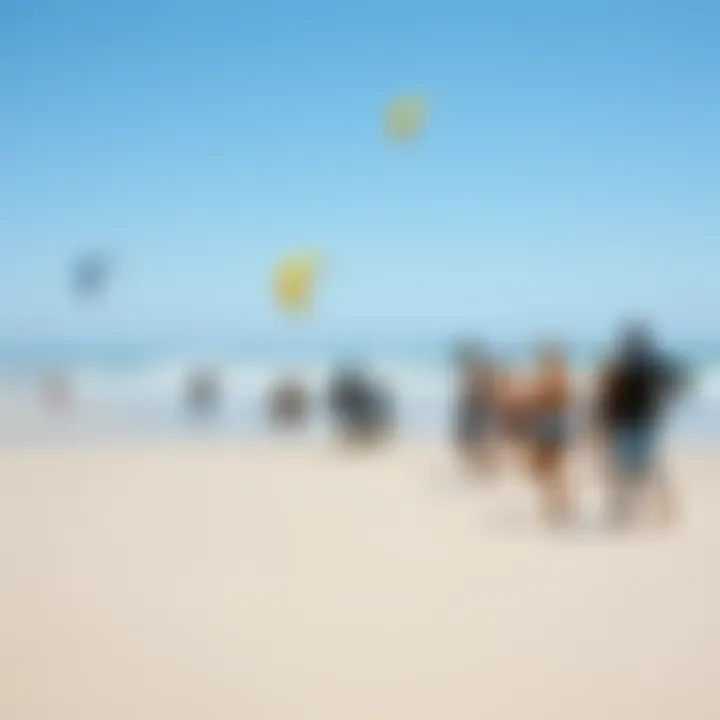
Setting Goals
When embarking on the kiteboarding journey, it's important to define where you want to go with your skills. Setting specific goals not only keeps you motivated but also gives your practice a direction and purpose. It's somewhat akin to charting a course before setting sail. Here are a few considerations to keep in mind:
- Skill-based Goals: Think about why you started kiteboarding. Is it to master jumps, learn how to surf with the kite, or explore different locations? Having skill-focused objectives will help you monitor your progress effectively.
- Timeline: Establish timeframes for reaching these goals. For instance, aim to learn basic jumps within a month or smooth transitions in two weeks. Having a timeline keeps the adrenaline flowing and provides checkpoints to assess your growth.
- Flexibility: Life throws curveballs, so it’s key to remain adaptable. If you hit a snag, adjust your goals instead of feeling like you've hit a brick wall. Achieving progress is not a straight line.
The journey of a thousand miles begins with one step.
— Lao Tzu
Common Challenges and Solutions
In kiteboarding, challenges are a part of the game. Recognizing and addressing these hurdles can be the tincture that brings sweet relief from frustration. Here are some typical challenges you might encounter and how to tackle them effectively:
- Wind Conditions: Adjusting to variable wind can be tricky for novices. Not every day is ideal for kiteboarding, and sometimes, patience is required. Seek guidance from experienced riders or instructors about what wind conditions are best for your current skill level.
- Equipment Adjustments: New kiteboarders might struggle with figuring out their gear. It’s excellent to familiarize yourself with different kites and boards and how they react to your maneuvers. Consider conducting a trial-and-error session with various equipment during your lessons to discover what works best for you.
- Physical Fatigue: A common pitfall is underestimating the physical aspect of kiteboarding. It can be physically exhausting, especially for newbies. To counter this, engage in physical training focusing on core strength and endurance outside of lesson times.
- Mental Blocks: Fear can loom large when learning new tricks or experiencing the dynamics of the ocean waves. Incorporate positive self-talk and visualization techniques. Mentally picturing yourself successfully executing a maneuver can sometimes work wonders. Furthermore, don't hesitate to lean on your instructors for support; they are seasoned in helping you through these mental barriers.
To round it all off, achieving progress in kiteboarding requires a mix of setting clear objectives and facing challenges head-on. Equipped with these strategies, riders are better prepared to tackle the waves and winds of the San Francisco waters, making each session not just a learning experience, but a step closer towards mastering this exhilarating sport.
The Kiteboarding Community in San Francisco
Kiteboarding in San Francisco is more than just a thrilling water sport; it embodies a vibrant community, one that plays a pivotal role in shaping the experiences of both beginners and experts alike. This segment centers around the intrinsic value that the kiteboarding community offers—an avenue for growth, shared knowledge, and lasting camaraderie.
Community engagement in kiteboarding not only fosters skills enhancement but also encourages a culture of safety and support among enthusiasts. Whether you’re a beginner just getting your feet wet or a seasoned pro eager to master new tricks, connecting with fellow kiteboarders opens doors to various learning experiences that can be tremendously beneficial.
There are several elements that underscore the importance of a strong kiteboarding community:
- Shared Experiences: Gathering with others who share a passion for kiteboarding cultivates a sense of belonging. Individuals trade tips, tricks, and even equipment recommendations.
- Mentorship Opportunities: Seasoned kiteboarders often mentor newcomers, offering invaluable insights that can quicken the learning curve. An experienced kiteboarder might offer you tricks of the trade that aren’t found in manuals or instructional videos.
- Support Network: Navigating challenges on the water can be daunting. Having a community to rely on can serve as a safety net, providing assistance not only when things go awry but also during training sessions when motivation may wane.
"The community isn’t just about the sport; it's about building relationships with people who understand your passion and challenges."
In essence, being part of the kiteboarding community in San Francisco enriches the learning and riding experiences, turning casual water ventures into extraordinary adventures.
Finding Local Clubs
Locating local kiteboarding clubs in San Francisco is easier than one might expect. Not only do these clubs offer organized lessons and events, but they also serve as hubs of knowledge. Here are a few notable clubs to consider:
- San Francisco Kiteboarding Club: A well-established club, offering members access to lessons, equipment rentals, and social events centered around kiteboarding.
- Bay Area Kiteboarding: Known for its strong community focus, this club organizes regular meet-ups, competitions, and workshops for all levels.
- Kiteboarding Safety Alliance: An initiative focused on safety and community education, providing an excellent resource to enhance skills and awareness on the water.
These clubs can often be found online, where you can check their schedules, membership details, and awareness campaigns that benefit local riders while promoting responsible kiteboarding practices.
Networking Opportunities
Engaging with the kiteboarding community in San Francisco opens up a treasure trove of networking opportunities. Whether seeking to connect with local businesses, find potential sponsors, or simply make friends in the sport, here are some effective ways to get involved:
- Social Media Groups: Platforms like Facebook and Reddit host various kiteboarding groups where enthusiasts discuss tips, organize meet-ups, and share experiences.
- Local Events and Competitions: Participating in local kiteboarding events not only enhances your skills but also presents chances to connect with potential sponsors and like-minded riders.
- Workshops and Clinics: Many clubs and schools organize workshops focusing on specific skills, providing environments conducive to networking and teaming up with more experienced riders.
- Meet-Up Events: Clubs frequently have social events that encourage casual mingling. Attend these gatherings to foster friendships, partnerships, and collaborative training sessions.
In summary, the kiteboarding community in San Francisco is a dynamic and supportive network, vital for cultivating personal growth and enhancing technical skills. By proactively engaging with clubs and fellow kiteboarders, one can enrich their own experience while contributing to a vibrant culture centered around the sport.
Kiteboarding Events and Competitions
Kiteboarding events and competitions play a crucial role in fostering camaraderie among enthusiasts, pushing individual skill levels, and showcasing the thrilling prowess of kiteboarders. San Francisco, with its vibrant community and prime conditions, hosts numerous events that draw competitors and spectators alike. These gatherings not only offer a chance to witness top-tier performances but also serve as a forum for learning and sharing knowledge among kiteboarding aficionados. Engaging in these events can help participants gauge their progress, network with likeminded individuals, and gain insights from seasoned professionals.
Upcoming Events
If you're keen on diving into the kiteboarding scene in San Francisco, you'll be pleased to know that several events are on the horizon. Here are some noteworthy gatherings to keep an eye on:
- San Francisco Kiteboarding Festival: An annual highlight where athletes from various backgrounds come together to compete in different categories. The festival also includes workshops, demos, and opportunities for beginners to try their hand at the sport.
- North American Kiteboarding Championship: A prestigious event attracting kiteboarders from across the continent. Attendees can witness high-caliber competition while participating in various spectator activities.
- Local Meet-ups and Competitions: Regularly organized by local clubs and communities, these events provide a more informal setup for kiteboarders to challenge themselves and enjoy the sport.
Mark your calendars and check local listings or community boards for updated schedules and specific dates, as they can change depending on weather conditions and regulations.
Participation Tips
Participating in kiteboarding events, especially for newcomers, can seem daunting. However, with the right approach, you can make the most of your experience. Here are some practical tips to help you navigate the scene effectively:
- Register Early: Many events have limited spots. Sign up as soon as registration opens to ensure your place and avoid last-minute rushes.
- Know the Rules: Familiarize yourself with competition rules and formats. Each event may have specific regulations you’ll need to abide by, including safety gear requirements and conduct during heats.
- Practice: If you plan to compete, give yourself ample time to prepare. Hone your skills in conditions similar to those expected during the competition.
- Network: Don’t be shy—meet fellow participants. Engaging with others can lead to new friendships and helpful tips that will enhance your experience.
- Stay Hydrated and Fueled: Kiteboarding can be physically demanding. Remember to eat well and stay hydrated, particularly before and during events.
By making the effort to immerse yourself in kiteboarding events, you’ll find not just a platform for competition, but also a vibrant community that inspires growth and enjoyment in the sport.
"In kiteboarding, every wave and gust of wind is a new canvas to paint your story. Participate, learn, and connect to truly embrace the thrill of the journey."
End: Embracing Kiteboarding Adventures
As we wrap up this comprehensive exploration of kiteboarding lessons in San Francisco, it's essential to grasp not just the technical tips and tricks but the spirit and adventure that this sport brings. Kiteboarding isn’t merely about harnessing wind and riding waves; it’s a pathway to connection—both with nature and with fellow enthusiasts.
For newcomers, kiteboarding can initially seem daunting. However, through the guidance of experienced instructors and a supportive community, the learning curve becomes not just manageable, but exhilarating. Picture yourself standing on a surfboard with the wind filling your kite, ready to ride the waves in the vibrant waters of San Francisco Bay. The sense of freedom and empowerment is hard to overstate.
Benefits of Engaging in Kiteboarding:
- Physical Fitness: This sport involves a workout that challenges your core, legs, and arms, ensuring you stay in great shape while having fun.
- Mental Resilience: Navigating the challenges that come with learning kiteboarding builds confidence and tenacity.
- Social Connections: Joining a kiteboarding community opens up opportunities to meet like-minded individuals, share experiences, and embark on new adventures together.
A few considerations should also be highlighted. First, kiteboarding is weather-dependent, making it important to stay updated on regional conditions before heading out. Second, always honor safety procedures and local regulations to ensure your experiences are not only enjoyable but also responsible. The windy hills of San Francisco often mean unpredictable conditions, so being adaptable and ready for change is key.
In summation, kiteboarding is more than just a sport; it’s an adventure that can transform how you perceive both your surroundings and your abilities. The journey of learning is filled with ups and downs, but with the right attitude and resources, you can truly embrace everything that kiteboarding has to offer. So grab your gear, find a trusted instructor, and dive into the captivating world of kiteboarding!
"Adventure awaits those willing to ride the winds and embrace the waves."
Remember, whether you're a seasoned pro or a novice eager to learn, San Francisco's waters invite you to connect, explore, and enjoy the exhilarating ride that kiteboarding promises.

